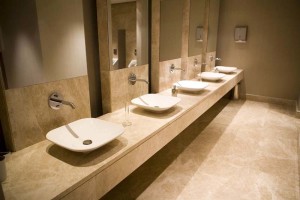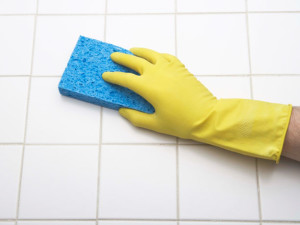Cleaning Commercial Bathrooms
Information on Cleaning Commercial Bathrooms
 Perhaps we’re just a nation with impossibly high standards. Then again, maybe building managers across the country really are missing out on an important chance to make a good impression. Either way, the fact is that at least 50 percent of the public’s complaints about buildings concern the upkeep of restrooms. Happily, this is something that cleaning professionals are increasingly determined to fix. This article from cleanlink.com – the complete article can be seen here
Perhaps we’re just a nation with impossibly high standards. Then again, maybe building managers across the country really are missing out on an important chance to make a good impression. Either way, the fact is that at least 50 percent of the public’s complaints about buildings concern the upkeep of restrooms. Happily, this is something that cleaning professionals are increasingly determined to fix. This article from cleanlink.com – the complete article can be seen here
According to industry professionals, there is an increase in public awareness of what one can acquire from dirty restrooms. Because of this, owners, operators, manufacturers, distributors and suppliers are all working hard to come up with systems and processes to make cleaning easier, safer, faster and better.
Indeed, relatively recent innovations in restroom cleaning range from ergonomically designed toilet-bowl brushes and environmentally safe citrus-based cleansers to color-coded and even touch-free cleaning systems. Combined with old-fashioned common sense and attention to detail, the new cleaning improvements make it easier and safer than ever to leave a restroom sparkling.
The definition of clean
Because the definition of ‘clean’ is very subjective and varies from one environment to another, it is important for building managers to determine what they’re looking for in terms of cleanliness.
With the exception of critical care areas, such as those found in some health care facilities or food service environments, there are few, if any, broadly established standards for cleaning.
As a starting point, the International Sanitary Supply Association’s (ISSA) Web site offers a 12-step set of general guidelines (here and here) entitled “How to Properly Clean a Restroom.” It’s a handy reminder that counter tops should be cleaned by starting at the back splash and working toward the drain, for example, and that expendable supplies such as paper towels should always be restocked.
A workable cleaning schedule is also important. Most restrooms are cleaned once a day and sometimes monitored throughout the day, but restrooms with high traffic volume, such as those in airports, may need attention hourly.
According to experts, managers and operators who thoroughly assess the overall use of each restroom in their facility, and who devise cleaning schedules that accommodate the need for regular cleaning and maintenance, as well as incidental and as-needed portering, will have far fewer restroom complaints.
The five biggest challenges
 Once the basics have been established – how clean and how often – cleaning professionals still face every restroom’s “Top Five.” These are the five most typical restroom complaints and the most common cleaning challenges that jan/san workers face. They are:
Once the basics have been established – how clean and how often – cleaning professionals still face every restroom’s “Top Five.” These are the five most typical restroom complaints and the most common cleaning challenges that jan/san workers face. They are:
1) Cross-contamination hazards
2) Soap and towel dispensers that don’t work
3) Unsightly garbage
4) Soiled or stained surfaces
5) Persistent odors
Cross-contamination: There are a number of ways to prevent the spread of germs when cleaning a restroom. First, experts say, kill the germs by using disinfectant solutions properly.
In order to achieve disinfection, it is important to carefully follow label directions. More often than not, the directions will include specifics on how the cleaner is to be applied, as well as the length of time that it should remain on surfaces in order to achieve the required disinfection levels.
Other recommendations include using a color-coded system when cleaning. With a system like this, tools that are one color can be used for cleaning toilets, while a different color can be reserved for bright works. This type of system will make sure that management, as well as the cleaning staff, doesn’t use any of these tools outside the restroom.
Touch-free cleaning is another method that reduces the risks of cross-contamination. Although the idea of touch-free cleaning is newer than traditional cleaning, departments continue to experiment with its features. With these systems, cleaning personnel never have to touch a contaminated surface. Instead, users clean with an all-in-one machine featuring a pressure washer, chemical injection and a wet-dry vacuum.
Soap and towel dispensers that don’t work: This is a case where back-ups make sense. Managers may wish to consider offering patrons both hand towel machines and air dryers, for instance, so that there will always be an alternative if one or the other can’t be used. Conscientious service, repair, and replacement of machines also helps eliminate this common complaint.
Unsightly garbage: Regardless of whether a restroom is disinfected properly, unsightly garbage can make it appear unsanitary. Studies show that people often use a towel on door handles when leaving restrooms and if a garbage receptacle isn’t nearby, they often drop the towel on the floor. Analyzing traffic and these types of use patterns will help determine whether alternate placement or additional receptacles are needed.
Soiled or stained surfaces: An obvious first step in cleaning would be the removal of visible soiling. Both the nature of the surface and the nature of the soil will affect which tools and cleansers to use. Degreasers, for instance, might be just the ticket for some of the surface stains found in fast-food restaurant facilities.
Industry manufacturers advise that users proceed with caution when using various cleansers. There are many very aggressive cleaners, which can remove soils but will also harm finishes. Surface damage only makes maintaining cleanliness and appearance that much more difficult in the future. Thus, selection of the mildest, yet effective cleaners is the best approach to balance these factors.
Persistent odors: When dealing with this common complaint, building managers are advised to look down – at the grout or the floor drain.
Often times, odor-causing bacteria can be found in grout lines where mops may not reach. If this is the case, it may be helpful to re-evaluate the products used to do this cleaning.
Other times the best thing to do is to look up, because light fixtures and even ceilings can harbor bacteria or mildew spores. It is important to note that thorough ventilation is especially important in higher humidity environments such as restrooms and may reduce these types of odors.
Managers dealing with a lot of traffic in and out of restrooms, such as those found in schools and airports, for instance, should carefully assess regular cleaning schedules to make sure these problems are addressed.
At The Service Fort, we work to build relationships and create partnerships with our customers, vendors and employees. We have unique janitorial program services that leave your commercial bathroom spaces looking and smelling fantastic. If you’re interested in implementing a program for you and your employees to enjoy a healthier workplace, contact us to get started.




